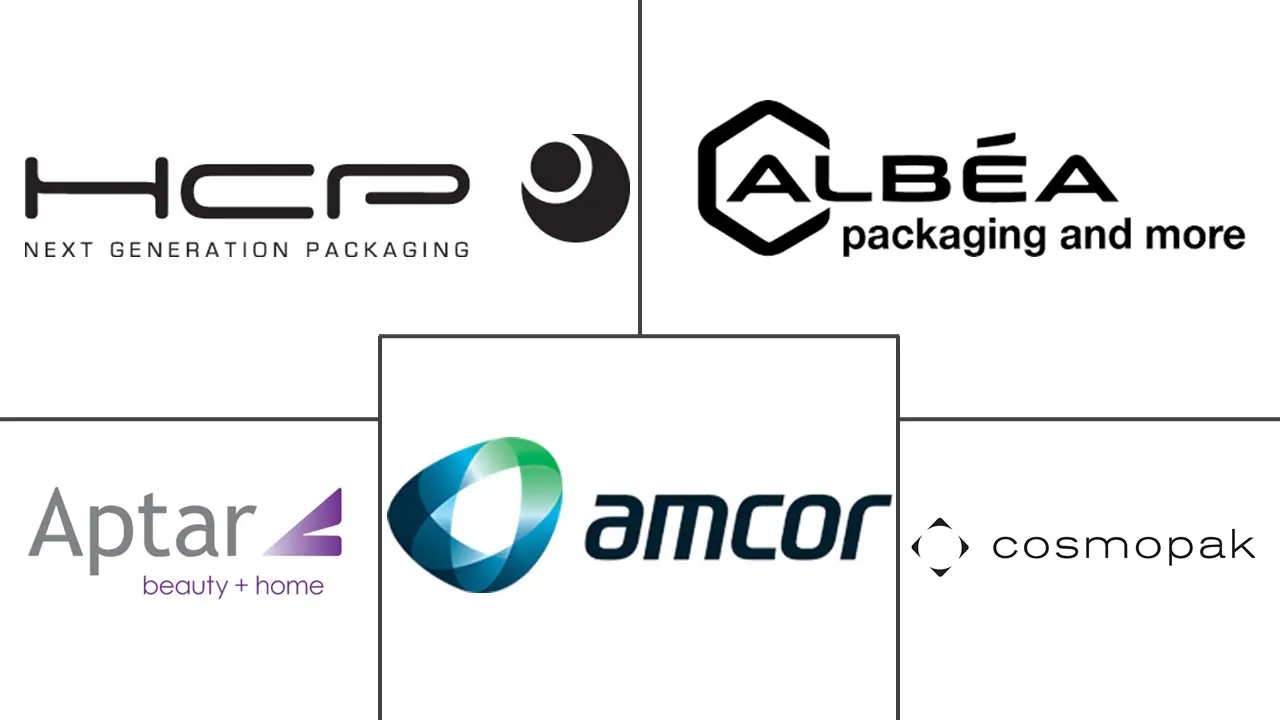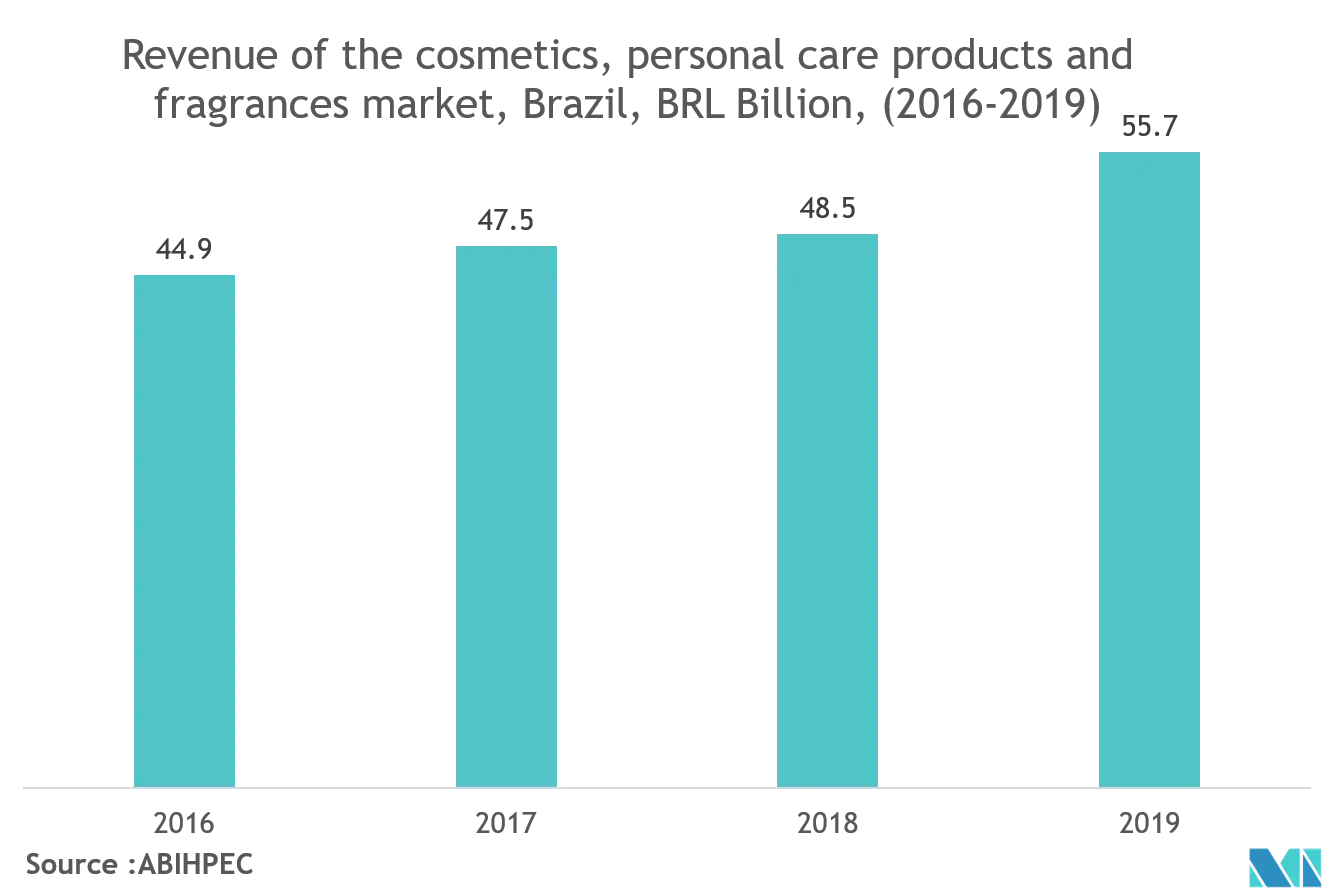Latin America Cosmetic Packaging Market Size

| Study Period | 2019 - 2029 |
| Base Year For Estimation | 2023 |
| Forecast Data Period | 2024 - 2029 |
| Historical Data Period | 2019 - 2022 |
| CAGR | 4.40 % |
| Market Concentration | Low |
Major Players
*Disclaimer: Major Players sorted in no particular order |
Latin America Cosmetic Packaging Market Analysis
Latin America Cosmetic Packaging Market is estimated to grow at a CAGR of about 4.4% over the forecast period (2020 - 2025). The economic sectors in the region including cosmetics, fragrances, and toiletries play a crucial role not only from an economic and financial perspective but also from a social and sustainability viewpoint, owing to the number of workers that compose the markets, and also the growing investments towards sustainable packaging initiatives drive the market growth.
- There are multiple investments in environmental policies followed in the region for sustainable development. For instance, in Brazil, resources are being invested in natural resource management, nature conservation, and the R & D of environmentally friendly products and processes, such as using green plastic in the packaging and the development of supplier partners communities of natural ingredients and assets.
- Similarly, Mexico is witnessing a growing number of environmentally concerned consumers. Although they are still limited in terms of overall presence, it is expected to increase during the forecast period. This is one of the primary reasons that emerging brands with natural positioning consider the packaging to be an important part of their product concept.
- For instance, the Mexican cosmetic sector is the second-largest market in Latin America after Brazil. According to the Mexican Chamber of Cosmetic Products (CANIPEC), the Mexican cosmetics market's value is estimated at more than USD 10.5 billion, ranking second in Latin America and 11th in the world. This indicates that the Mexican cosmetic market is growing faster, mostly driven by the rising urban lifestyle. Moreover, leading brands are launching new products to support market growth in the region.
- Further, There has been a constant decline in the money being spent by people in the cosmetics and personal care category in regions such as Argentina, primarily due to the economic challenges arising from the drop in the country's currency value. Such an economic slowdown is expected to create opportunities for small packages and cheap packaging in the market. This is expected to create opportunities for the growth of plastics, which are relatively less expensive to manufacture and reduce vendors' logistics costs. In many product categories that are considered essential, like toothpaste, customers remained loyal to brands but purchased smaller units to reduce spending.
- Additionally, owing to the ongoing coronavirus pandemic, the region is witnessing increased demand for alcohol-based gels and soaps to tackle the pandemic. Multiple companies are responding to this increased need for products. For instance, in Apr 2020, in the Colombian city of Cali, a cosmetic company modified its production to face the COVID-19 outbreak and swaps the production facility to manufacture antibacterial soaps and gels for hospitals, nursing homes, and pharmacies.
Latin America Cosmetic Packaging Market Trends
This section covers the major market trends shaping the Latin America Cosmetic Packaging Market according to our research experts:
Increase spend on Personal Care products to drive the market
- Among all personal care product categories, skincare, haircare, fragrances, and makeup are expected to experience the adoption during the forecast period. For instance, the Solar exposure awareness undertaken by CANIPEC in the previous years is contributing to the growth of dual functionality cosmetics that cater to the customers' makeup and skincare requirements.
- According to Invest in Bogota, the investment promotion agency of Bogota, the cosmetics market size is expected to reach USD 3.96 billion by 2022. The growth in the country has been primarily due to the gradual rise in per capita incomes in recent years, which has resulted in increased spending on cosmetics and personnel care products.
- The hair care products demand is increasing due to the growing adoption of grooming products and the popularity of beards among men. The haircare sector represents 20% of the personal care market in Mexico. The sector is also expected to experience healthy growth during the forecast period.
- The growth potential that this market offers, coupled with the customers' price sensitivity, is expected to localize the production of cosmetics and their packaging in the future. For instance, in August 2019, Avon opened a state-of-the-art research facility in Mexico to support its existing plant in Celaya and develop products targeting the local market. Tarsus purchased the remaining 40% of its joint venture with Expo Guadalajara to localize its presence in Mexico further.

Brazil to Register Significant Growth
- Brazil exports perfumery, cosmetic, and bath products to Argentina, Colombia, and Chile and imports cosmetics from France, Argentina, and the United States. The country remains dependent on imports for finished products. This has led the Brazilian government to introduce import taxes to localize the production. Companies like Albea are focusing on localizing their cosmetic packaging activities as much as possible.
- Further, the Brazilian cosmetics industry is gaining from an untapped demographic dividend, which is progressively using more cosmetic products. According to KOTRA, a state-funded trade and investment promotion organization operated by the government of South Korea, there has been a continuous increase in the number of male consumers buying cosmetic products in Brazil. SEBRAE or Brazilian Support Service for Micro and Small Enterprises, stated that the men's cosmetics market has tripled in Brazil in the past five years. By 2021, it will become the largest men's cosmetics market in the world. This is expected to facilitate further growth of packaging modules designed exclusively for use by men.
- In terms of products, the perfume segment has been continually growing, as body sprays for fragrances and deodorants remain highly popular. This leads to the growth of product categories, like dispensing systems and spray caps, required for these products. There is a trend supporting premiumization in this market. Despite being price-sensitive, Brazilians are willing to spend on cosmetics. According to the Brazil Institute of Geography & Statistics, healthcare and personal care products grew by 0.58% in September 2019, as consumers deemed them essential.
- Moreover, the market in the region is also witnessing investment activities. For instance, in Apr 2020, the French group of fragrances and aromas, Robertet, invested BRL 48 million in constructing a unit in São Paulo. With its operation, the company is now looking to triple its production and storage capacity. The unit allowed the company to increase its productivity. The company also added more advanced processes to meet environmental issues, such as waste treatment and rainwater reuse.

Latin America Cosmetic Packaging Industry Overview
The Latin America Cosmetic Packaging Market is moderately competitive. The vendors in the market leverage partnerships and acquisitions to expand their product reach and drive innovations. Further, the COVID-19 Impact, coupled with economic slowdowns in the region, is expected to drive significant opportunities for vendors offering cheaper packaging solutions.
- August 2019: Albea SA further invested in Nilpeter technology with the acquisition of new FA-presses for company sites in India, Brazil, and Poland. The collaboration between the two market-leading companies dates back to 2008 when Albea, through its former UK division, Betts Group, acquired two original FA-4 flexo presses for India and Indonesia locations.
- July 2019: HCP Packaging Co Ltd expanded its Mexico facility in Reynosa by significantly increasing the production floor space and double office space. The US and Mexico teams work closely together on the expansion program, utilizing strong collective experience to realize additional capacity for molding, vacuum metalizing, coating, decoration processes, and final assembly.
Latin America Cosmetic Packaging Market Leaders
-
Amcor PLC
-
Albéa Group
-
Aptar Beauty+Home
-
Cosmopak Corporation
-
Hcp Packaging Co., Ltd.
*Disclaimer: Major Players sorted in no particular order

Latin America Cosmetic Packaging Market Report - Table of Contents
1. INTRODUCTION
- 1.1 Study Assumptions and Market Definition
- 1.2 Scope of the Study
2. RESEARCH METHODOLOGY
3. EXECUTIVE SUMMARY
4. MARKET DYNAMICS
- 4.1 Market Overview
-
4.2 Market Drivers
- 4.2.1 Increasing Consumption of Cosmetic Products
- 4.2.2 Increasing Focus on Innovation and Attractive Packaging
-
4.3 Market Challenges
- 4.3.1 Growing Sustainability Concerns
-
4.4 Industry Attractiveness - Porter's Five Force Analysis
- 4.4.1 Bargaining Power of Suppliers
- 4.4.2 Bargaining Power of Consumers
- 4.4.3 Threat of New Entrants
- 4.4.4 Threat of Substitutes
- 4.4.5 Intensity of Competitive Rivalry
- 4.5 Industry Value Chain Analysis
- 4.6 Industry Policies
- 4.7 Assessment of Impact of Covid-19 on the Market
5. MARKET SEGMENTATION
-
5.1 Material Type
- 5.1.1 Plastic
- 5.1.2 Glass
- 5.1.3 Metal
- 5.1.4 Paper
-
5.2 Product Type
- 5.2.1 Plastic Bottles and Containers
- 5.2.2 Glass Bottles and Containers
- 5.2.3 Metal Containers
- 5.2.4 Folding Cartons
- 5.2.5 Corrugated Boxes
- 5.2.6 Tubes and Sticks
- 5.2.7 Caps and Closures
- 5.2.8 Pump and Dispenser
- 5.2.9 Droppers
- 5.2.10 Ampoules
- 5.2.11 Flexible Plastic Packaging
-
5.3 Cosmetic Type
- 5.3.1 Hair Care
- 5.3.2 Color Cosmetics
- 5.3.3 Skin Care
- 5.3.4 Men's Grooming
- 5.3.5 Deodorants
- 5.3.6 Other Cosmetic Types (Fragrances, Depilatories, Baby and Child Care, and Sun Care)
-
5.4 Country
- 5.4.1 Brazil
- 5.4.2 Mexico
- 5.4.3 Argentina
- 5.4.4 Other Countries
6. COMPETITIVE LANDSCAPE
-
6.1 Company Profiles*
- 6.1.1 Albea SA
- 6.1.2 HCP Packaging Co. Ltd.
- 6.1.3 RPC Group PLC (Berry Global Group)
- 6.1.4 Silgan Holdings Inc.
- 6.1.5 DS Smith PLC
- 6.1.6 Graham Packaging L.P.
- 6.1.7 Libo Cosmetics Company Ltd.
- 6.1.8 AptarGroup Inc.
- 6.1.9 Amcor PLC
- 6.1.10 Cosmopak Ltd.
- 6.1.11 Quadpack Industries SA
- 6.1.12 Rieke Corp.
- 6.1.13 Gerresheimer AG
- 6.1.14 Raepak Ltd.
7. INVESTMENT ANALYSIS
8. FUTURE OUTLOOK
** Subject To AvailablityLatin America Cosmetic Packaging Industry Segmentation
This study characterizes the cosmetic packaging market, based on the type of packaging which includes Plastic, Glass, Metal, and Paper. The scope of this study is currently focused on regions across Latin America.
| Material Type | Plastic |
| Glass | |
| Metal | |
| Paper | |
| Product Type | Plastic Bottles and Containers |
| Glass Bottles and Containers | |
| Metal Containers | |
| Folding Cartons | |
| Corrugated Boxes | |
| Tubes and Sticks | |
| Caps and Closures | |
| Pump and Dispenser | |
| Droppers | |
| Ampoules | |
| Flexible Plastic Packaging | |
| Cosmetic Type | Hair Care |
| Color Cosmetics | |
| Skin Care | |
| Men's Grooming | |
| Deodorants | |
| Other Cosmetic Types (Fragrances, Depilatories, Baby and Child Care, and Sun Care) | |
| Country | Brazil |
| Mexico | |
| Argentina | |
| Other Countries |
Latin America Cosmetic Packaging Market Research FAQs
What is the current LA Cosmetic Packaging Market size?
The LA Cosmetic Packaging Market is projected to register a CAGR of 4.40% during the forecast period (2024-2029)
Who are the key players in LA Cosmetic Packaging Market?
Amcor PLC, Albéa Group, Aptar Beauty+Home , Cosmopak Corporation and Hcp Packaging Co., Ltd. are the major companies operating in the LA Cosmetic Packaging Market.
What years does this LA Cosmetic Packaging Market cover?
The report covers the LA Cosmetic Packaging Market historical market size for years: 2019, 2020, 2021, 2022 and 2023. The report also forecasts the LA Cosmetic Packaging Market size for years: 2024, 2025, 2026, 2027, 2028 and 2029.
Latin America Cosmetic Packaging Industry Report
Statistics for the 2024 Latin America Cosmetic Packaging market share, size and revenue growth rate, created by Mordor Intelligence™ Industry Reports. Latin America Cosmetic Packaging analysis includes a market forecast outlook to 2029 and historical overview. Get a sample of this industry analysis as a free report PDF download.



